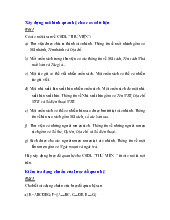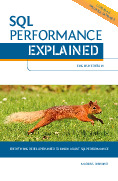







Preview text:
CSE 444 Practice Problems Query Optimization 1. Query Optimization Given the following SQL query:
Student (sid, name, age, address) Book(bid, title, author) Checkout(sid, bid, date) SELECT S.name
FROM Student S, Book B, Checkout C WHERE S.sid = C.sid AND B.bid = C.bid
AND B.author = ’Olden Fames’ AND S.age > 12 AND S.age < 20 And assuming:
• There are 10, 000 Student records stored on 1, 000 pages.
• There are 50, 000 Book records stored on 5, 000 pages.
• There are 300, 000 Checkout records stored on 15, 000 pages.
• There are 500 different authors.
• Student ages range from 7 to 24. 1
(a) Show a physical query plan for this query, assuming there are no indexes and data is not sorted on any attribute. Solution:
Note: many solutions are possible. On the fly Πname On the fly
σ12Tuple-base nested loop 1bid Block nested loop 1sid Scan: Book Scan: Student Scan: Checkout
Figure 1: One possible query plan (all joins are nested-loop joins)
(b) Compute the cost of this query plan and the cardinality of the result. Solution: Cost Cardinality Remarks S 1 C B(S) + B(S) * B(C) 300000 (foreign-key (1) = 1000 + 1000 * 15000 join) = 15001000 (S 1 C) 1 B T(S 1 C) * B(S) 300000 (foreign-key (2) = T(C) * B(S) join) = 300000 * 5000 = 1500000000 σ and Π On the fly 300000 * σauthor * σage (3) = 300000 * 1 500 ∗ 7 18 ≈ 234 Total 1515001000 234
(1) We are doing page at a time nested loop join. Also, the output is pipelined to next join.
(2) The output relation is pipelined from below. Thus, we don’t need the scanning term for outer relation.
(3) We assume uniform value distributions for age and author. We assume independence among participating columns. 2
(c) Suggest two indexes and an alternate query plan for this query. Solution:
Note: many solutions are possible. For purposes of illustation, we assume an unclustered B+-tree
index on Book.author and a clustered B+tree index on Checkout.bid: Πname On the fly σ12On the t fly fl 1sid Block nested loop On the fly Πsid Scan: Student Indexed nested loop 1bid Πbid Index Scan: Book
σauthor=0OldenFames0 Index Scan: Checkout
Figure 2: One possible query plan that uses the two indexes
(d) Compute the cost of your new plan. Solution:
N(B) = # of tuples per page for Book = T(B)/B(B) = 10
N(C) = # of tuples per page for Checkout = T(C)/B(C) = 20 Cost Cardinality Remarks Index Scan T(B) * 1/V(B) 100 (1) on Book = 50000 ∗ 1 500 with σauthor = 100 Πsid(B 1 C)
100 ∗ d(T (C)/V (bid))/N(C)e 100*T(C)/ Max( 100, V(C,bid) ) (2)
= 100 ∗ d(300000/50000)/20e = 600 = 100 1sid B(S) = 1000 ≈ 234 (3) Total 1200
(1) We assume all intermediate index pages are in memory. Note: because bid is the search-key
for the index, the bid values are in the leaf pages of the index: they are thus in memory as per the
first assumption. Because we project on bid right after the selection, we only need these values,
so we do not really need to perform any disk I/Os.
(2) One index lookup per outer tuple. Assuming uniform distribution, there will be 6 checkouts
per book. Assuming all intermediate index pages are in memory, the 6 records can be fetched
with only one or two disk accesses since we have a clustered index on Checkount.bid. The above
computation is optimistic but it only incurs 100 more I/Os in the worst case.
(3) Again, the output of the previous operation is projected on sid. Because there are only 600
tuples, it is reasonable to assume all results can hold in memory. Since the outer relation is
already in-memory, we only need to scan the inner relation Student one time. 3
(e) Explain the steps that the Selinger query optimizer would take to optimize this query. Solution:
A query optimizer explores the space of possible query plans to find the most promising one. The
Selinger query optimizer performs the search as follows:
• Only considering left-deep query plans.
Instead of enumerating all possible plans and evaluating their costs, the optimizer keeps the
efficient pipelined execution model in mind. Thus, it only looks for left-deep query plans and
enumerates different join orders. It considers cartesian products as late as possible to reduce
I/O costs. It considers only nested-loop and sort-merge joins. • In bottom-up fashion.
The optimizer starts by finding the best plan for one relation. It then expands the plan
by adding one relation at a time as an inner relation. For each level, it keeps track of the
cheapest plan per interesting output order, which will be explained shortly, as well as the
cheapest plan overall. When computing the cost of a plan, the Selinger considers both I/O cost and CPU cost.
• Considering interesting orders.
If the query has an ORDER BY or a GROUP BY clause, having results ordered by the
columns that appear in those clauses can reduce the cost of the query plan because it can
save extra I/Os needed by sort or aggregation. Similarly, attributes that appear in join
conditions are considered interesting orders because they reduce the cost of sort-merge joins.
When the Selinger optimizer evaluates a plan, at each stage, it keeps track of the cheapest
plan per interesting order in addition to the cheapest plan overall. 4 2. Query Optimization
Consider the following SQL query that finds all applicants who want to major in CSE, live in Seattle,
and go to a school ranked better than 10 (i.e., rank < 10). Relation
Cardinality Number of pages Primary key
Applicants (id, name, city, sid) 2,000 100 id Schools (sid, sname, srank) 100 10 sid Major (id, major) 3,000 200 (id,major) SELECT A.name FROM
Applicants A, Schools S, Major M WHERE A.sid = S.sid AND A.id = M.id AND
A.city = ’Seattle’ AND S.rank < 10 AND M.major = ’CSE’ And assuming:
• Each school has a unique rank number (srank value) between 1 and 100.
• There are 20 different cities.
• Applicants.sid is a foreign key that references Schools.sid.
• Major.id is a foreign key that references Applicants.id.
• There is an unclustered, secondary B+ tree index on Major.id and all index pages are in memory.
(a) What is the cost of the query plan below? Count only the number of page I/Os. (One-the-fly) (6) π name
(One-the-fly) (5) σ major = ‘CSE’ (Index nested loop) (4) id = id (Sort-merge) (3) sid = sid Major (1) σ city=‘Seattle’ (2) σ srank < 10 (B+ tree index on id) Applicants Schools (File scan) (File Scan) 5 Solution:
The total cost of this query plan is 119 I/Os computed as follows:
• (1) The cost of scanning Applicants is 100 I/Os. The output of the selection operator is 100 20 = 5 pages or 2000 20 = 100 tuples.
• (2) The cost of scanning Schools is 10 I/Os. The selectivity of the predicate on rank is 10−1
100 = 0.09. The output is thus 0.09 ∗ 10 ≈ 1 page or 0.09 ∗ 100 ≈ 9 tuples.
• (3) Given that the input to this operator is only six pages, we can do an in-memory sort-merge
join. The cardinality of the output will be 9 tuples. There are two ways to compute this: (a) 100∗9
(max(100,9)) = 9 (see book Section 15.2.1 on page 484) or (b) consider that this is a key-foreign
key join and each applicant can match with at most one school but keep in mind that the
predicates on city and rank were independent, hence only 0.9 of the applicants end-up with a matching school.
• (4) The index-nested loop join must perform one look-up for each input tuple in the outer
relation. We assume that each student only declares a handful of majors, so all the matches
fit in one page. The cost of this operator is thus 9 I/Os.
• (5) and (6) are done on-the-fly, so there are no I/Os associated with these operators.
(b) The Selinger optimizer uses a dynamic programming algorithm coupled with a set of heuristics
to enumerate query plans and limit its search space. Draw two query plans for the above query
that the Selinger optimizer would NOT consider. For each query plan, indicate why it would not be considered. Solution:
Many solutions were possible including:
A plan that joins Schools with Major first Right-deep plans are
would not be considered because π name not considered either. π name
it would require a cartesian product that can be avoided σ
major = ‘CSE’ and city=‘Seattle’ σ major = ‘CSE’ (Nested loop) (Nested loop) id = id id = id Major (Nested loop) (Sort-merge join Applicants (File scan) and write to file) sid = sid (File scan) σ srank < 10 σ city=‘Seattle’ σ srank < 10 Major Schools (File scan) Applicants Schools (File Scan) (File scan) (File Scan) 6 3. Query Optimization
Consider the schema R(a,b), S(b,c), T(b,d), U(b,e).
(a) For the following SQL query, give two equivalent logical plans in relational algebra such that one
is likely to be more efficient than the other. Indicate which one is likely to be more efficient. Explain. SELECT R.a FROM R, S WHERE R.b = S.b AND S.c = 3 Solution: i. πa(σc=3(R ./b=b (S))) ii. πa(R ./b=b σc=3(S)))
ii. is likely to be more efficient
With the select operator applied first, fewer tuples need to be joined.
(b) Recall that a left-deep plan is typically favored by optimizers. Write a left-deep plan for the
following SQL query. You may either draw the plan as a tree or give the relational algebra
expression. If you use relational algebra, be sure to use parentheses to indicate the order that the joins should be performed. SELECT * FROM R, S, T, U WHERE R.b = S.b AND S.b = T.b AND T.b = U.b Solution: ((R ./b=b S) ./b=b T ) ./b=b U 7
(c) Physical plans. Assume that all tables are clustered on the attribute b, and there are no secondary
indexes. All tables are large. Do not assume that any of the relations fit in memory.
For the left-deep plan you gave in (b), suggest an efficient physical plan.
Specify the physical join operators used (hash, nested loop, sortmerge, etc.) and the access
methods used to read the tables (sequential scan, index, etc.). Explain why your plan is efficient.
For operations where it matters, be sure to include the details — for instance, for a hash join,
which relation would be stored in the hash tables; for a loop join, which relation would be the
inner or outer loop. You should specify how the topmost join reads the result of the lower one. Solution:
join order doesn’t matter, sortmerge for every join, seqscan for R,S,T,U. Fully pipelined.
“clustered index scan” instead of seqscan is also correct.
(d) For the physical plan you wrote for (c), give the estimated cost in terms of B(...), V (...), and
T (...). Explain each term in your expression. Solution:
B(R) + B(S) + B(T ) + B(U). Just need to read each table once. 8




